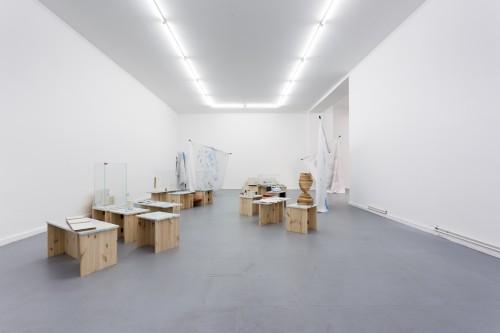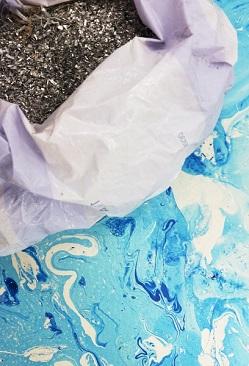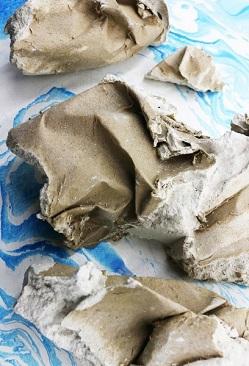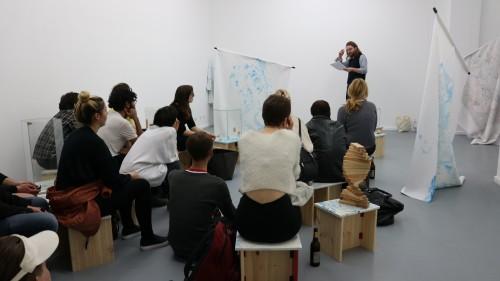Have you met... Lorenzo Sandoval
Have you met... Lorenzo Sandoval

Bpigs team has decided unanimously: the most wanted artist to be featured on the B-Side of our May/June issue is Lorenzo Sandoval, a prolific figure in the Berlin art scene who recently presented a site-specific body of work at L'atelier-ksr.
His latest show, "Deep Surface", reflects upon a set of elements within the different stages of art production, and the parts that remain hidden in the process of showing final results; quasi-labour and hidden lapses, such as an economy of affection, the knot of precariousness, support and maintenance, and "übermateriality".
We asked Lorenzo to share some thoughts on the show and the topics revolving around it, on his creative work and his multifaceted involvement in the arts.

"Broken Parliament", 2016 Spatial device. "Curriculum Vitae", 2013 – ongoing
Collection of objects from sidejobs since 2012. © L'atelier-ksr
What is your recent exhibition, "Deep Surface", all about?
The exhibition is a starting point of the lack of solid references. It is about the difficulties to produce common spaces and identities, but also ways of living. I related the project to the idea of ‘gelification’, a reference from the Spanish philosopher Santiago Lopez Petit. Gelification is a metaphor for advanced capitalism, which he uses to expand Zygmunt Bauman's idea of liquidity. It is a kind of shapeless shape that fits very well with how the obsolescence works as a constant fluctuation; with how things that surround us appear and disappear all the time. That applies to objects in capitalism, but also to the constant flux of images modulating our desires. Through the different parts of the exhibition, the works are in one hand a reflection of a lack of stability, and on the other hand, within the program, it is more of a proactive situation – proposing a meeting place, like an adaptable agora.


"Broken Parliament", 2016 Spatial device. "Curriculum Vitae", 2013 – ongoing Collection of
objects from sidejobs since 2012. Details. © L'atelier-ksr
Could you tell us more about the contributions by other practitioners in the part of the show called "Interventions"?
"Interventions" are a way to expand some of the ideas I was working with in the exhibition. I wanted to have some other practitioners involved, so that it was not just my own voice. For instance, I was interested in Paul Feigelfeld's work because he is dealing with the archives of media theorist Friedich Kittler. In his late work, he was reflecting about the Odyssey. Also, he was exploring the direct connections between the forms of the vowels with sonority in Greek. I explore this concept to a previous project called "A Soft Tragedy" I did last year in collaboration with Kinderhook & Caracas that had presence in the exhibition. Then, I invited John Holten who I have a long personal and professional relationship. Over time we engaged in many in-depth conversations on questions related to cartography, relationships, precarity, spatialized narration, and so on. Suza Husse was introducing a project we did together a few years ago, called "Dissident Desire". We were putting together translations, from activist, queer and feminist positions, to everyday life strategies, producing an archive, three exhibitions and a series of performative interventions. Now we are working on the publication to be a continuation of "Dissident Desire". Lastly, I invited Deborah Ligorio because I am very interested in the way she works about notions of care, ecology, and the body.

"When The Map Meets The Territory". An essay-fiction by John Holten. © L'atelier-ksr
Which topics do you mainly explore in your work?
I am interested in finding ways to understand my surroundings, how these things are affecting my very private life, but also how they connect with other more universal questions. For example, I work a lot from the idea of the ‘endotic’. It is one of the things I have been working on the last couple of years. Endotic is a term coined by Georges Perec as an antonym for 'exotic'. He was proposing it to explore the everyday life without the figure of the other, a way of finding our own anthropology.
I am also very interested in the different positions thinking about the body as a political platform, about how social-economical fluxes can be traced in the different processes of the body. For example, I come back constantly to the idea of the ‘somatheque’ by Paul B. Preciado. Other thing I am very interested in is how to build institutions, trying to propose ways of produce common grounds that can host individual voices. But I would say that the list of interests grows constantly and it changes depending on the contexts I am working with.
What projects are you currently involved in?
I am working on the publication of “Dissident Desire” with Suza Husse. Another publication I am working on is an ongoing research I have been carrying out with Emanuele Guidi, called "Spaces of Anticipation", soon to be published in On Curating magazine. One more project I have been running for one year now is "The Institute for Endotic Research", a fictional institution with an operative program, which I use to establish collaborations with other practitioners, and reflect about institution makings and self-educational programs. I am participating in "An Age of Our Own Making", a project curated by Bonaventure Soh Bejeng Ndikung and Solvej Helweg Ovesen. In the third part of the project I am going to do a new installation, which will be working as a display, called "The Editors Room".
Your educational background is in photography, and right now you are mainly working as an artist and curator, while shifting between different roles – curator, writer, lecturer... How does your practice expand, and how do these things interfere?
When I was finishing my university degree, I started to work a lot in collectives. Already then I was working with very different roles. With the contemporary conditions and constant mobilization we have to be switching roles constantly, so I try to push this transdisciplinary situation as a productive force to reflect upon this phenomena. I find important to understand this betweenness means within the different practices, and then explore the potentialities of these different roles at the same time instead of trying to close my identity. It is something that a lot of people are doing now, not necessarily because they want to, but because there is no other choice. In most cases you cannot really survive doing just one thing. If you think about how many artists are also designers, or professors, or how the university professors also have to be translators, or how there are a lot of people having several different jobs, you can see that it is becoming a problem. I think it is good to have a very proactive position of finding what you can get from this kind of crisis of work. Because at the end, what we are facing it is a growing crisis of working conditions in western societies.
What is coming next?
I will have a project next month at the Broken Dimanche Büro, continuing the “Deep Surface” show at L'Atelier- ksr. Then I’m participating in "Secluded Insulation" curated by Geo-Vanna at Rockelmann&. Another project I am working on is about the relationship between early computation, the beginning of distribution of images and the processes of industrialization. The starting point I am researching about is crystallizes in the friendship of Charles Babbage and Henry Talbot. The former was a pioneer of the implementation of the Jacquards looms to, along with Ada Lovelace, conceptualize first computers. The later was one of the inventors of how to make photographs reproducible. Some of the early images of fabrics that Talbot printed were coming from machines programmed by Baggage. I want to study this knot of relationships as one of the many lines that bring us were we are.
* * * * *
Find out more about Lorenzo's work at lorenzosandoval.net